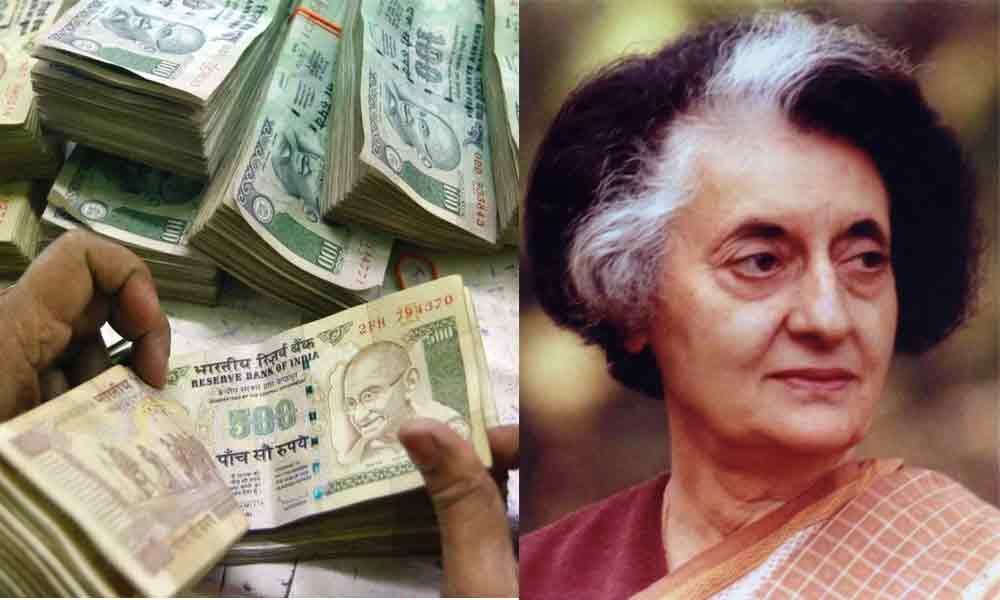Live
- PM Modi highlights govt's efforts to make Odisha prosperous and one of the fastest-growing states
- Hezbollah fires 200 rockets at northern, central Israel, injuring eight
- Allu Arjun's Family Appearance on Unstoppable with NBK Breaks Viewership Records
- Unity of hearts & minds essential for peace & progress, says J&K Lt Governor
- IPL 2025 Auction: I deserve Rs 18 cr price, says Chahal on being acquired by Punjab Kings
- EAM Jaishankar inaugurates new premises of Indian embassy in Rome
- Sailing vessel INSV Tarini embarks on second leg of expedition to New Zealand
- Over 15,000 people affected by rain-related disasters in Sri Lanka
- IPL 2025 Auction: RCB acquire Hazlewood for Rs 12.50 cr; Gujarat Titans bag Prasidh Krishna at Rs 9.5 crore
- Maharashtra result reflects the outcome of Congress' destructive politics: BJP's Shazia Ilmi
Just In

Fifty years ago, Indian banking system underwent a major shift.
Fifty years ago, Indian banking system underwent a major shift. Those were the days when we did not have the social media nor the mobile phones nor even TV sets on a large scale.
I was in my ninth standard and was travelling home from school in the evening by Delhi Transport Corporation bus when an evening newspaper was being sold like hot cakes. Out of curiosity I also purchased a copy and it had a screaming headline, 'Indira Gandhi decides to nationalise banks'.
Though I read the story, I was not really clear as to what exactly it meant and how it would help the country. Later in the evening, there was a sort of a round table meeting in my house consisting of senior government officials who were friends of my father and also one MP.
The discussion veered around the tectonic decision of bank nationalisation. Some were praising then Prime Minister Indira Gandhi while a couple of them were sceptical about the outcome of this decision and felt that it would complicate the system.
50 years down the lane, it can be said that the decision of Indira Gandhi had certainly brought a turnaround in the financial scenario of India.
It resulted in the banking sector making a major contribution to the society and helping in poverty eradication to a great extent. Indira Gandhi who was also known as 'Iron Lady' nationalised 20 banks in two phases - 14 banks on July 19, 1969 and six more in April 1980.
With this, 91 percent of the banking system came under government control.
Till nationalisation, the private sector banks were liberal in lending to business houses and big industries. The common man had virtually no chance to get easy loans.
Following the nationalisation, 20 nationalised banks plus SBI and its associates emerged as a strong banking network and slowly but steadily took the banking services to the door step of the common man.
The mobilisation of rural and semi urban credit had become easy. The private banks never wanted to touch the rural sector as they felt that it may not be possible to recover the loans.
The government, during the first five years of nationalisation, constituted various study groups which focussed on priority sector lending. Then in the next five years, the attention was paid to agriculture, industry and trade.
The centre went a step ahead and set up a statutory body called National Bank for Agriculture and Rural Development (NABARD) to promote sustainable and equitable agriculture and rural development through participative financial and non-financial interventions, innovations, technology and institutional development for securing prosperity.
During this period, many regional rural banks had also come up and the officials started visiting villages and farm enterprises.
Another benefit of nationalisation was that several small and marginal farmers who never got any financial help except from the private money lenders got introduced to banking system and lending for agriculture and small-scale industries also began.
In other words, banks started reaching the common man. This helped in making a good beginning of transformation of village economy.
The Reserve Bank of India describes bank nationalisation as the "single-most important economic policy decision taken by any government after 1947." Central bank historians say that in terms of the impact, even the economic reforms of 1991 pale in comparison.
In the late sixties, India was facing great financial stress. There were two successive years of drought and the country had not yet recovered from the financial troubles following the China war in 1962 and war with Pakistan in 1965.
There was a food shortage and the country was heavily dependent on food imports from US public investments which were at lowest ebb. On one hand, the Congress had suffered a setback in 1967 elections and headed for a split.
Internal security was in bad shaped as Naxalite menace was growing.
In the face of such a situation, the financial situation came as another major blow for the Central government and in 1966 it decided to devalue the rupee. Fortunately for the country, it proved to be an economic success.
Against the backdrop of this scenario, the nationalisation of banks worked wonders. The public sector banks played a key role in implementation of various welfare schemes launched by the government by coordinating with district to block level agencies and served as a conduit to disburse subsidies.
This helped the State governments in taking up integrated rural development schemes, debt waiver schemes etc. The outcome was that a clear change in the economic conditions of rural enterprise started becoming visible.
As the patronage for banking sector improved, the banks started opening more and more branches in the rural areas. From a little over of 8,000 branches at the time of nationalisation, they have now grown to nearly 1.5 lakh branches and the unorganised credit started falling sharply.
In addition, now the government has also introduced, 1.26 lakh bank mitras (business correspondents) provide branchless banking in villages.
So far so good. But there is the flipside of nationalisation as well. The government control over the banks had virtually resulted in introduction of the same culture as that of government offices where in the name of rules and regulations, customer care had hit a rock bottom.
This had led to the PSBs losing competitive spirit and edge. The controls from the government also resulted in loss of autonomy and they almost stopped working on commercial lines.
Since the government used to mandate that they should open certain number of branches whether there was business potential or not, they started getting into red.
The governance was poor, and the control of the government appointed directors never allowed them to have any kind of freedom and even non-performing assets increased manifold. This also resulted in the increasing influence of large borrowers on certain decisions.
Soon after the demonetisation, the PSBs got further exposed. They did not have adequate infrastructural facilities and to retain profits they came up with high service charges.
However, the bank nationalisation, despite triumphs and tribulations, greatly contributed to the robust growth of banking outreach, more importantly in the hinterland, benefiting people at the bottom of the pyramid.

© 2024 Hyderabad Media House Limited/The Hans India. All rights reserved. Powered by hocalwire.com







